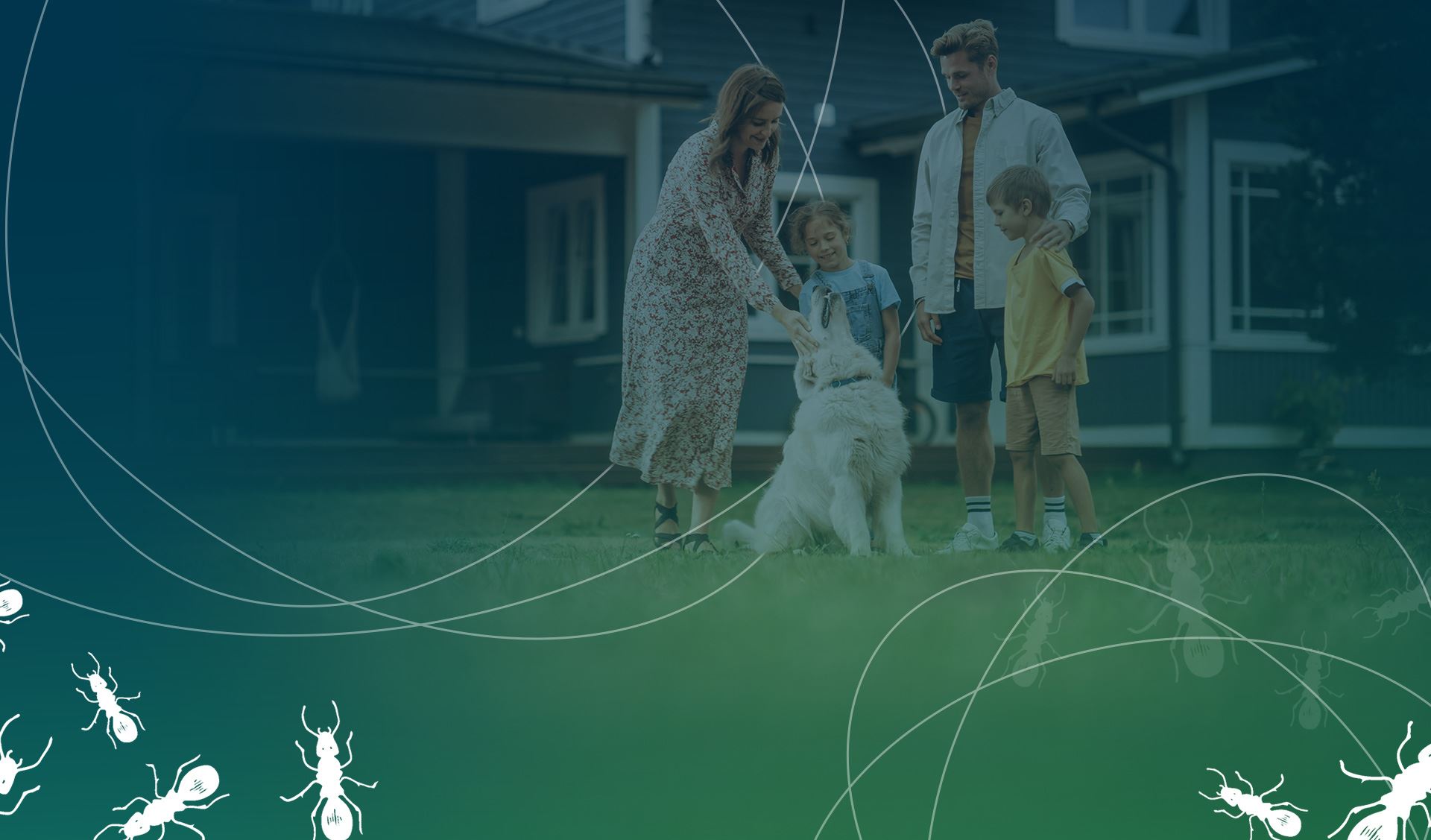
COLUMBIA FLEA CONTROL
Stop Flea Bites from Affecting You or Your Pets
Fleas are well-known for biting animals like cats and dogs. However, did you know that fleas can affect humans in addition to pets? That’s why you should never hesitate to call Modern Exterminating for Columbia flea control services. Backed by over 60 years of experience, our team has the skills and experience to get rid of your flea problem ASAP. We offer treatment and extermination methods that are safe for you, your family members, and your pets.
Our company has built a reputation on having a “PHD” in customer care—that’s professionalism, dependability, and honesty. And with same-day service available upon request, there’s never a bad time to call Modern Exterminating for reliable flea control in Columbia, Lexington, Aiken, or the surrounding communities.
Modern Exterminating is available by phone at (803) 205-2744. Call our Columbia pest removal pros for all your flea needs.
Ridding Your Home of Fleas
Ridding a home of fleas can be a frustrating and costly endeavor, because unlike some pests encountered in the home, fleas cause discomfort and irritation for both pets and people. Fleas also account for more than half of all dermatological conditions requiring veterinary assistance in pets, and even a single flea bite to a hypersensitive animal or person may cause intense itching and irritation. For successful flea control, the home, pet, and oftentimes, the yard must be treated.
Yet the manner in which these treatments are performed can greatly influence the results, which is why it’s so important to hire a professional like one of our technicians at Modern Exterminating. Check out the following information designed to help frustrated pet owners effectively rid their homes and pets of fleas, and remember that do not hesitate to call our Columbia flea control pros at Modern Exterminating for more information.
Understanding Fleas: Key Information for Columbia Residents
- Adult fleas (the biting stage seen by pet owners) spend most of their time on the animal, not in the carpet. This is why treatment of the pet in conjunction with the pet’s environment is an essential step in ridding a home of fleas.
- Adult fleas lay all of their eggs (up to 50 per day) on the pet. However, the eggs soon fall off the animal into carpeting, beneath the cushions of furniture, and wherever else the pet rests, sleeps, or spends most of its time. This is where homeowners should focus control measures.
- After hatching, flea eggs develop into tiny, worm-like larvae. Larvae remain hidden deep in carpet fibers, beneath furniture cushions and in other protected areas. The larvae feed mainly on adult flea feces (dried blood) that accumulates, along with the eggs, in pet resting and activity areas.
- Before becoming adult fleas, the larvae transform into pupae within a silk-like cocoon. Pupae remain inside the cocoon for two to four weeks (sometimes longer.) The cocoon is resistant to insecticides and this is why some adult fleas are seen for an extended period of time, even after the home and pet are treated.
Identifying Flea Bites and Their Effects on Humans and Pets
In humans, flea bites usually occur on the lower body on places like ankles or feet, but they can happen anywhere. They tend to be grouped together and have a scabbed, red appearance. Some people may not have much of a reaction at all to fleas and only notice flea activity on their pets.
Effective Flea Control Solutions for Your Columbia Home
If you neglect to treat your pet’s environment, you will miss more than 90% of the developing flea population: the eggs, larvae, and pupae. If your pet spends time indoors, the interior of the home should also be treated.
Pre-Treatment Checklist for Columbia Homeowners
- Remove all toys, clothing, and stored items from floors, under beds, and in closets. This step is essential so that all areas will be accessible for treatment.
- Remove pet food and water dishes, cover fish tanks, and disconnect their aerators.
- Wash, dry-clean, or destroy all pet bedding.
- Vacuum!
This last step is particularly important, as vacuuming removes many of the eggs, larvae and pupae developing within the home. Vacuuming also stimulates pre-adult fleas to emerge sooner from their insecticide-resistant cocoons, thus hastening their contact with insecticide residues in the carpet. By raising the nap of the carpet, vacuuming improves the insecticide’s penetration down to the base of the carpet fibers where the developing fleas live.
Always vacuum thoroughly before flea treatment, especially in areas where pets rest or sleep. Don’t forget to vacuum along edges of rooms and beneath furniture, cushions, beds, and throw rugs. After vacuuming, seal the vacuum bag in a garbage bag and discard it in an outdoor trash container.
Insecticide Application for Your Columbia, SC Flea Problem
Once fleas become established in a home, insecticides are almost always needed to control them. It is important to always read and follow label directions on the insecticide container. Other than the person performing the application, people and pets should be out of the house during treatment. People and pets should also remain off treated surfaces until the spray has dried. This may take several hours, depending on carpet type, ventilation, and method of application. Opening windows and running the fan or air conditioner after treatment will enhance drying and minimize odor.
Products Modern Exterminating may recommend for flea treatment include:
- Raid Flea Killer Plus®
- Siphotrol Plus®
- Bio Flea Halt™
- Fleatrol®.
Most homeowners will find aerosol formulations easier to apply than liquids. Moreover, aerosol products which can be dispensed by hand – and thus directed under and behind beds, furniture, etc. – tend to be more effective than “foggers” or “bug bombs” which are indiscriminately set off in the center of a room. It is essential that the application be thorough and includes all likely areas of flea development. Carpets, throw rugs, under and behind beds and furniture, and beneath cushions on which pets sleep should all be treated. Pay particular attention to areas where pets spend time or sleep, as these will be the areas where most flea eggs, larvae, and pupae will be concentrated. For example, if the family cat sleeps within a closet, or hides under the bed, these areas must be treated or the problem will continue. Hardwood and tile floors generally do not require treatment, but should be thoroughly vacuumed.
Expect to see some fleas for two to four weeks or longer following treatment. Provided all infested areas were treated initially, these “survivors” are probably newly emerged adults which have not yet succumbed to the insecticide. Instead of retreating the premises immediately, continue to vacuum. As noted earlier, vacuuming stimulates the insecticide-resistant pupae to hatch, bringing the newly emerged adults into contact with the insecticide sooner. Flea traps, such as those utilizing a light and glue board to attract and capture adult fleas, can be helpful but will not eliminate a flea infestation unless used in combination with other methods. If adult fleas continue to be seen beyond two to four weeks, retreatment of the premises (and pet) may be necessary.
For Professional Flea Control Service in Columbia & Surrounding Areas, Call Today
If you are looking for affordable pest control, Modern Exterminating has you covered. We proudly offer a number of deals and specials to accommodate your budget. We also provide complimentary consultations, so you never have to commit to service before you are comfortable. Our Columbia, SC flea exterminators are highly trained and certified to get the job done right, so you can always trust our treatment recommendations. And as a local, family-owned company with experience dating back to 1955, you won’t find a more committed flea control company in the area than Modern Exterminating.
To request flea control service in Columbia, call (803) 205-2744, or send us a message online.

Understanding the Flea Life Cycle: Key to Effective Extermination
To effectively combat a flea infestation, it's essential to understand the flea life cycle. Fleas undergo four stages: egg, larva, pupa, and adult. This knowledge can help you grasp why a single treatment may not suffice and why a comprehensive approach is necessary.
Here's a brief overview of each stage:
- Eggs: Flea eggs are tiny, white, and often fall off the host into carpets, bedding, and other areas. They can hatch within a week under ideal conditions.
- Larvae: These are small, worm-like creatures that feed on organic debris and flea feces. They thrive in dark, moist environments.
- Pupae: Flea larvae spin cocoons and enter the pupal stage, where they can remain dormant for several months, waiting for the right conditions to emerge as adults.
- Adults: Once they emerge, adult fleas can jump onto pets or humans and begin the cycle anew, making early intervention crucial.
By understanding this life cycle, you can appreciate the importance of ongoing treatments and preventive measures. Our trained professionals at Modern Exterminating Company, Inc. can guide you through the entire process, ensuring that every stage of the flea life cycle is effectively targeted. This comprehensive approach not only rids your home of current infestations but also helps prevent future outbreaks.
Why Choose Modern Exterminating Company, Inc.?
Choosing the right pest control service is critical to achieving long-lasting results. Here’s why Modern Exterminating Company, Inc. stands out:
- Experienced Technicians: Our team is trained in the latest flea control techniques and products, ensuring effective and safe solutions for your home.
- Customized Treatment Plans: We assess your unique situation and tailor our services to meet your specific needs, ensuring maximum effectiveness.
- Eco-Friendly Options: Concerned about the environment? We offer eco-friendly treatment options that are safe for your family and pets.
- Ongoing Support: Our commitment doesn’t end after treatment. We provide ongoing support and advice to help you maintain a flea-free home.
Don’t let fleas take over your space. Contact us today to schedule a consultation and take the first step toward a flea-free home!
What Are Some Signs of a Flea Infestation in My Home?
Common signs include seeing fleas on your pets, finding flea dirt (small black specks) in pet bedding or carpets, and noticing excessive scratching or grooming by your pets.
How Long Does It Take for a Flea Treatment to Work?
Treatment effectiveness can vary, but you may continue to see fleas for two to four weeks as newly emerged adults come into contact with the insecticide. Regular vacuuming can help speed up the process.
Can I Treat Fleas on My Pets and My Home at the Same Time?
Yes, it's important to treat both your pets and the home simultaneously to effectively eliminate the flea lifecycle. Consult your veterinarian for appropriate pet treatments.
How Often Should I Vacuum During a Flea Treatment Process?
You should vacuum daily during the treatment period to help stimulate any remaining flea eggs or pupae and bring them into contact with the insecticide.


We Understand What's Important
-
Your Satisfaction Is Guaranteed!

We are all about results and customer care, this is why we will do everything in our power to ensure you are happy with our services.
-
Local & Family Owned Business Since 1955
 We are proud to help keep your family safe, which is why pest control is not "just a job", it's in our blood and it has been for many generations.
We are proud to help keep your family safe, which is why pest control is not "just a job", it's in our blood and it has been for many generations. -
Same-Day Appointments & Services Available

We get it - you found bugs and you want them gone as soon as possible! Call (803) 205-2744 to schedule your same-day appointment.


Stay In The Know Check Out Our Pest Tips and Tricks
-
What to Do If You Find Ticks in Your Home
-
What is the Safest Type of Termite Control?
-
The Risks of DIY Pest Control for Businesses: Why You Need a Professional
-
What to Do If You Find Ticks in Your Home
-
Natural Pest Control Methods: An Eco-Friendly Guide
-
The Top 5 Pests That Threaten Restaurants and How to Combat Them
-
The Top 5 Most Common Pests That Affect Businesses: Prevention, Identification, and Treatment
-
The Financial Cost of Pest Infestations: Why Investing in Pest Prevention Pays Off





